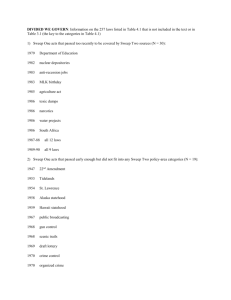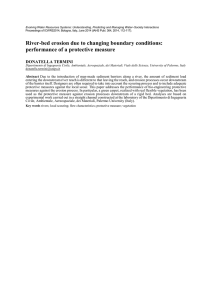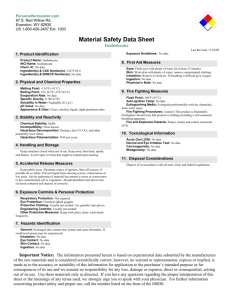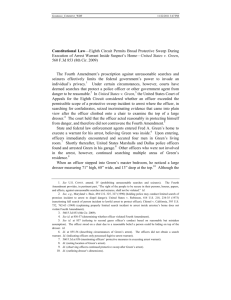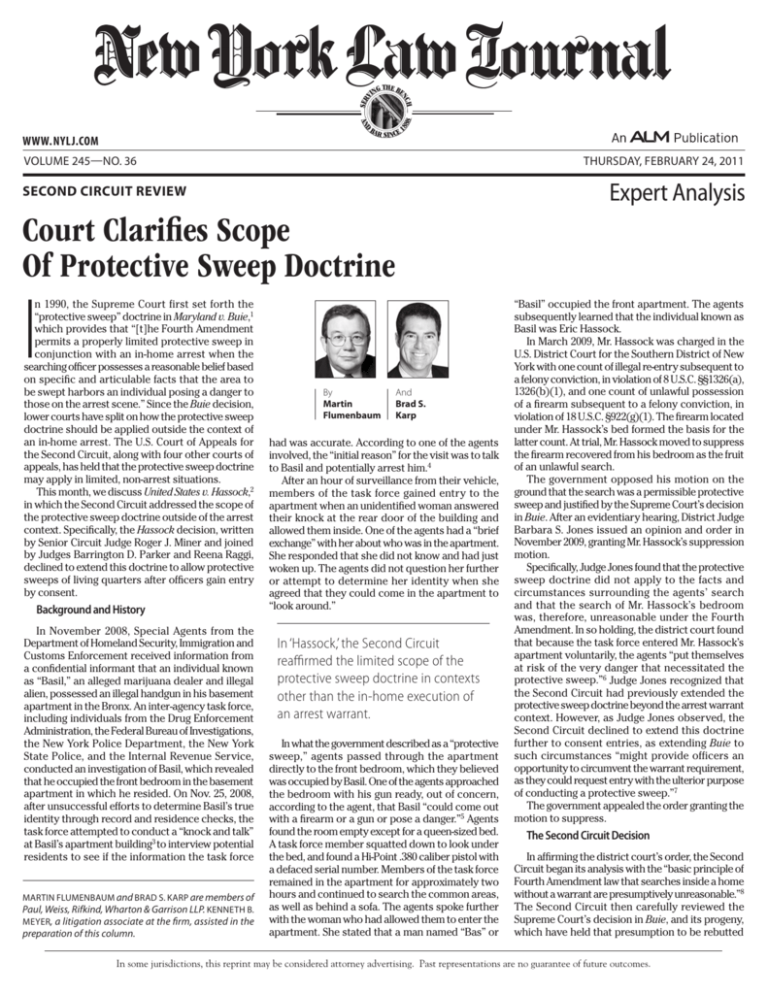
AND
88
8
SER
V
H
NC
THE BE
ING
1
BA
R SINCE
www. NYLJ.com
thursday, February 24, 2011
Volume 245—NO. 36
Expert Analysis
Second Circuit Review
Court Clarifies Scope
Of Protective Sweep Doctrine
I
n 1990, the Supreme Court first set forth the
“protective sweep” doctrine in Maryland v. Buie,1
which provides that “[t]he Fourth Amendment
permits a properly limited protective sweep in
conjunction with an in-home arrest when the
searching officer possesses a reasonable belief based
on specific and articulable facts that the area to
be swept harbors an individual posing a danger to
those on the arrest scene.” Since the Buie decision,
lower courts have split on how the protective sweep
doctrine should be applied outside the context of
an in-home arrest. The U.S. Court of Appeals for
the Second Circuit, along with four other courts of
appeals, has held that the protective sweep doctrine
may apply in limited, non-arrest situations.
This month, we discuss United States v. Hassock,2
in which the Second Circuit addressed the scope of
the protective sweep doctrine outside of the arrest
context. Specifically, the Hassock decision, written
by Senior Circuit Judge Roger J. Miner and joined
by Judges Barrington D. Parker and Reena Raggi,
declined to extend this doctrine to allow protective
sweeps of living quarters after officers gain entry
by consent.
Background and History
In November 2008, Special Agents from the
Department of Homeland Security, Immigration and
Customs Enforcement received information from
a confidential informant that an individual known
as “Basil,” an alleged marijuana dealer and illegal
alien, possessed an illegal handgun in his basement
apartment in the Bronx. An inter-agency task force,
including individuals from the Drug Enforcement
Administration, the Federal Bureau of Investigations,
the New York Police Department, the New York
State Police, and the Internal Revenue Service,
conducted an investigation of Basil, which revealed
that he occupied the front bedroom in the basement
apartment in which he resided. On Nov. 25, 2008,
after unsuccessful efforts to determine Basil’s true
identity through record and residence checks, the
task force attempted to conduct a “knock and talk”
at Basil’s apartment building3 to interview potential
residents to see if the information the task force
Martin Flumenbaum and Brad S. Karp are members of
Paul, Weiss, Rifkind, Wharton & Garrison LLP. Kenneth B.
Meyer, a litigation associate at the firm, assisted in the
preparation of this column.
By
Martin
Flumenbaum
And
Brad S.
Karp
had was accurate. According to one of the agents
involved, the “initial reason” for the visit was to talk
to Basil and potentially arrest him.4
After an hour of surveillance from their vehicle,
members of the task force gained entry to the
apartment when an unidentified woman answered
their knock at the rear door of the building and
allowed them inside. One of the agents had a “brief
exchange” with her about who was in the apartment.
She responded that she did not know and had just
woken up. The agents did not question her further
or attempt to determine her identity when she
agreed that they could come in the apartment to
“look around.”
In ‘Hassock,’ the Second Circuit
reaffirmed the limited scope of the
protective sweep doctrine in contexts
other than the in-home execution of
an arrest warrant.
In what the government described as a “protective
sweep,” agents passed through the apartment
directly to the front bedroom, which they believed
was occupied by Basil. One of the agents approached
the bedroom with his gun ready, out of concern,
according to the agent, that Basil “could come out
with a firearm or a gun or pose a danger.”5 Agents
found the room empty except for a queen-sized bed.
A task force member squatted down to look under
the bed, and found a Hi-Point .380 caliber pistol with
a defaced serial number. Members of the task force
remained in the apartment for approximately two
hours and continued to search the common areas,
as well as behind a sofa. The agents spoke further
with the woman who had allowed them to enter the
apartment. She stated that a man named “Bas” or
“Basil” occupied the front apartment. The agents
subsequently learned that the individual known as
Basil was Eric Hassock.
In March 2009, Mr. Hassock was charged in the
U.S. District Court for the Southern District of New
York with one count of illegal re-entry subsequent to
a felony conviction, in violation of 8 U.S.C. §§1326(a),
1326(b)(1), and one count of unlawful possession
of a firearm subsequent to a felony conviction, in
violation of 18 U.S.C. §922(g)(1). The firearm located
under Mr. Hassock’s bed formed the basis for the
latter count. At trial, Mr. Hassock moved to suppress
the firearm recovered from his bedroom as the fruit
of an unlawful search.
The government opposed his motion on the
ground that the search was a permissible protective
sweep and justified by the Supreme Court’s decision
in Buie. After an evidentiary hearing, District Judge
Barbara S. Jones issued an opinion and order in
November 2009, granting Mr. Hassock’s suppression
motion.
Specifically, Judge Jones found that the protective
sweep doctrine did not apply to the facts and
circumstances surrounding the agents’ search
and that the search of Mr. Hassock’s bedroom
was, therefore, unreasonable under the Fourth
Amendment. In so holding, the district court found
that because the task force entered Mr. Hassock’s
apartment voluntarily, the agents “put themselves
at risk of the very danger that necessitated the
protective sweep.”6 Judge Jones recognized that
the Second Circuit had previously extended the
protective sweep doctrine beyond the arrest warrant
context. However, as Judge Jones observed, the
Second Circuit declined to extend this doctrine
further to consent entries, as extending Buie to
such circumstances “might provide officers an
opportunity to circumvent the warrant requirement,
as they could request entry with the ulterior purpose
of conducting a protective sweep.”7
The government appealed the order granting the
motion to suppress.
The Second Circuit Decision
In affirming the district court’s order, the Second
Circuit began its analysis with the “basic principle of
Fourth Amendment law that searches inside a home
without a warrant are presumptively unreasonable.”8
The Second Circuit then carefully reviewed the
Supreme Court’s decision in Buie, and its progeny,
which have held that presumption to be rebutted
In some jurisdictions, this reprint may be considered attorney advertising. Past representations are no guarantee of future outcomes.
thursday, February 24, 2011
in the case of searches that fit within the definition
of a “protective sweep.”
In Buie, as the Hassock court explained, police
investigated the armed robbery of a restaurant by
two men, one of whom wore a red running suit. After
securing an arrest warrant and verifying that one
of the suspects, Jerome Buie, was at home, officers
entered his house and dispersed. One officer shouted
into the basement for anyone present to come out,
at which point Mr. Buie emerged and was arrested.
Another officer then entered the basement to search
for others who might be hiding and discovered a red
running suit in plain view, which he seized. Mr. Buie
unsuccessfully sought to suppress the running suit
and was subsequently convicted at trial.
As the Buie Court explained, at issue was “what
level of justification is required by the Fourth and
Fourteenth Amendments before police officers, while
effecting the arrest of a suspect in his home pursuant
to an arrest warrant, may conduct a warrantless
protective sweep of all or part of the premises.”9
Recognizing that there are contexts “where the
public interest is such that neither a warrant nor
probable cause is required” before officers may
conduct a search,10 the Supreme Court reviewed
its holdings in Terry v. Ohio11 and Michigan v.
Long,12 which held that, consistent with the Fourth
Amendment, police could conduct limited searches
for weapons “where a reasonably prudent officer
would be warranted in the belief, based on specific
and articulable facts…that he is dealing with an
armed and dangerous individual.”13
The Court found that those same principles
authorized the officers in Buie to conduct a “frisk”—a
limited protective sweep—of Mr. Buie’s basement to
ensure officer safety. As the Court held: “The Fourth
Amendment permits a properly limited protective
sweep in conjunction with an in-home arrest when
the searching officer possesses a reasonable belief
based on specific and articulable facts that the area
to be swept harbors an individual posing a danger
to those on the arrest scene.”14
As the Hassock court observed, the circuit courts
remain divided on the proper basis for entry into
a home before officers may conduct a protective
sweep. The U.S. Courts of Appeals for the Ninth and
Tenth circuits have read Buie narrowly, upholding
protective sweeps only when officers enter a dwelling
to make an in-home arrest.15 The U.S. Courts of
Appeals for the First, Fifth, Seventh, and D.C. circuits,
by contrast, have extended Buie to allow protective
sweeps of living quarters in non-arrest situations.
Moreover, the Fifth and D.C. circuits have upheld
protective sweeps where officers gain admittance
through consent.
The Second Circuit has joined the majority
of its sister circuits in concluding that Buie’s
reasonableness framework “may justify a protective
sweep in circumstances other than during
the in-home execution of an arrest warrant.”16
Specifically, in United States v. Miller, the Second
Circuit extended Buie to allow a protective sweep
where officers are present in a home “under lawful
process.” In Miller, officers entered an apartment
pursuant to an order of protection secured against
Alfred Miller, who had told his roommate that he
would “put a bullet through his head.”17 When Mr.
Miller asked if he could enter a bedroom, an officer
gave him permission to do so but followed him into
the bedroom for safety.18 Once inside, the officer
saw a shotgun, which ultimately led to Mr. Miller’s
conviction for possessing a firearm after a previous
conviction for a felony.
On appeal, the Second Circuit found that the
firearm was seized pursuant to a lawful protective
sweep. Relying on Terry, Long and Buie, the Second
Circuit held that “a law enforcement officer present
in a home under lawful process [such as an order
of protection] may conduct a protective sweep
when the officer possesses articulable facts which,
taken together with the rational inferences from
those facts, would warrant a reasonably prudent
officer in believing that the area to be swept
harbors an individual posing a danger to those
on the…scene.”19
The Second Circuit has twice been presented with
the issue of whether Buie allows protective sweeps
when officers enter a home based on consent, but
in each case left the issue unresolved. In each
instance, the court found that the officers had failed
to articulate specific facts to suggest that they were
in danger from hidden occupants.
In United States v. Gandia,20 however, the court
hinted that even if the officers had conducted a valid
protective sweep, the doctrine may not apply when
officers gain entry based on consent. As the court
stated in dicta: “Although we do not decide this issue,
we do note that when police have gained access
to a suspect’s home through his or her consent,
there is a concern that generously construing Buie
will enable and encourage officers to obtain that
consent as a pretext for conducting a warrantless
search of the home.”
The court’s decision leaves open the
question of whether the protective
sweep exception applies to other
situations, apart from an arrest or
legitimate process, where police are
lawfully on the premises for a legitimate
governmental reason.
In Hassock, the Second Circuit reaffirmed the
limitations of the protective sweep doctrine, but
declined to provide a clear answer as to whether the
doctrine applies only in cases where officers are on
the premises to effect an in-house arrest (as in Buie)
or to execute a legal process (as in Miller). In this
case, the court found that the protective sweep did
not apply, because the sweep was not antecedent
to any other legitimate purpose.
As the Court explained, “a protective sweep is
reasonable only to safeguard officers in the pursuit
of an otherwise legitimate purpose. Where no other
purpose is being pursued, a sweep is no different
from any other search and, therefore, requires a
warrant, exigency, or authorized consent.”21
In holding that the agents’ search was
unreasonable, the court recognized, as had the
district court, that it might have been objectively
reasonable for the agents to believe that Mr.
Hassock’s presence on the premises posed a danger
to their safety. Nonetheless, the court held that it
was not clear to the agents before they entered
the apartment whether the woman who granted
them access had authority to consent to a search of
the premises.
The court further found that even though the
officers went to Mr. Hassock’s apartment with a
legitimate purpose to question and possibly arrest
him, “that purpose could not be pursued until
Hassock was found.”22 When Mr. Hassock did not
answer the door, the “sweep” became the reason
for the agents to remain in the apartment as they
searched for Mr. Hassock. “Under the circumstances,”
the court held, “the officers undertook a full search
for the object of their inquiry rather than a protective
sweep incident to an independent lawful purpose”
and did so “without a warrant, proper consent,
exigent circumstances, or even probable cause to
believe that Hassock was present.”23 The search of
Mr. Hassock’s bedroom was therefore unreasonable
and in violation of the Fourth Amendment.
Conclusion
In Hassock, the Second Circuit reaffirmed the
limited scope of the protective sweep doctrine in
contexts other than the in-home execution of an
arrest warrant. However, the court’s decision leaves
open the question of whether the protective sweep
exception applies to other situations, apart from an
arrest or legitimate process, where police are lawfully
on the premises for a legitimate governmental reason.
It will be interesting to see how far the Second Circuit
is willing to extend Buie and whether the court will
follow the lead of its sister circuits in this important
area of Fourth Amendment law.
••••••••••••••••
•••••••••••••
1. 494 U.S. 325 (1990).
2. Docket No. 09-5193-cr, 2011 WL 257446 (2d Cir. Jan. 28,
2011).
3. Hassock, 2011 WL 257446, at 1.
4. Id.
5. Id. at 2.
6. United States v. Hassock, 676 F. Supp. 2d 154, 161-62 (S.D.N.Y.
2009).
7. Id. at 160 (quoting United States v. Miller, 430 F.3d 93, 100 n.3
(2d Cir. 2005)).
8. Hassock, 2011 WL 257446, at 4 (quoting Brigham City, Utah v.
Stuart, 547 U.S. 398, 403 (2006)).
9. Buie, 494 U.S. at 327.
10. Id. at 331.
11. 392 U.S. 1 (1968).
12. 463 U.S. 1032 (1983) (extending Terry to authorize limited
searches of the passenger compartment of an automobile based
on officer’s reasonable suspicion that the suspect is dangerous
and may gain control of weapons).
13. Buie, 494 U.S. at 331-32 (internal quotations and citations
omitted).
14. Id. at 337.
15. Compare United States v. Martins, 413 F.3d 139, 149 (1st
Cir. 2005) (upholding protective sweep where entry justified
by exigent circumstances); Leaf v. Shelnutt, 400 F.3d 1070, 1087
(7th Cir. 2005) (same); United States v. Gould, 364 F.3d 578, 590
(5th Cir. 2004) (en banc) (upholding protective sweep where cooccupant admitted officers to question defendant about threats);
and United States v. Patrick, 959 F.2d 991, 996-97 (D.C. Cir. 1992)
(upholding protective sweep where police entered on consent
of lessee) with United States v. Torres-Castro, 470 F.3d 992, 997
(10th Cir. 2006) (limiting protective sweeps to those “performed
incident to an arrest”) and United States v. Reid, 226 F.3d 1020,
1028 (9th Cir. 2000) (concluding warrantless search of apartment
was not a protective sweep and was not justified by exigent
circumstances).
16. Hassock, 2011 WL 257446, at 8 (quoting Miller, 430 F.3d at
100).
17. Miller, 430 F.3d at 96.
18. Id.
19. Id. at 98 (internal quotation marks omitted).
20. 424 F.3d 255, 262 (2d Cir. 2005).
21. Hassock, 2011 WL 257446, at 9.
22. Id.
23. Id.
Reprinted with permission from the February 24, 2011 edition of the NEW
YORK LAW JOURNAL © 2011 ALM Media Properties, LLC. All rights
reserved. Further duplication without permission is prohibited. For information,
contact 877-257-3382 or reprints@alm.com. # 070-02-11-42




